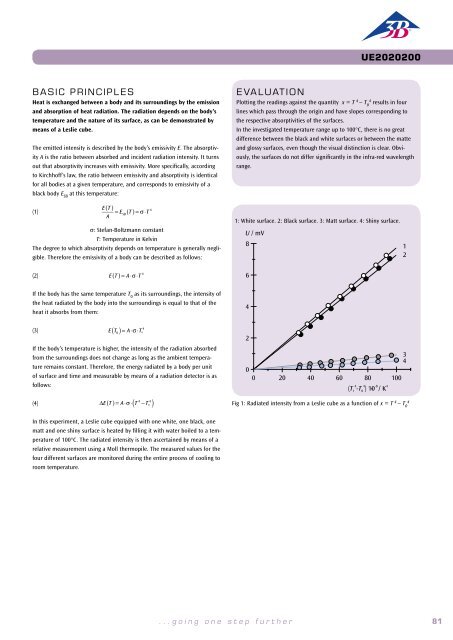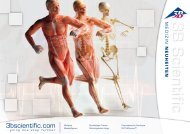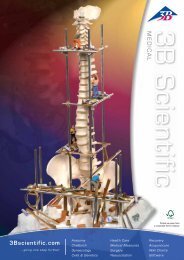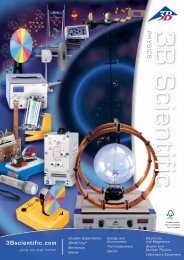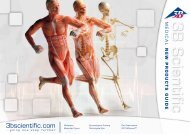3B Scientific - Physics & Engineering Experiments
3B Scientific - Physics & Engineering Experiments
3B Scientific - Physics & Engineering Experiments
You also want an ePaper? Increase the reach of your titles
YUMPU automatically turns print PDFs into web optimized ePapers that Google loves.
UE2030300<br />
HEAT / INTERNAL ENERGY<br />
Increase of Internal Energy<br />
by Mechanical Work<br />
UE2030300<br />
BASIC PRINCIPLES<br />
According to the First Law of Thermodynamics, the change of the internal<br />
energy of a system ΔE is equal to the sum of the work performed<br />
ΔW and the transferred heat ΔQ. It can be measured as the proportional<br />
change in the temperature of the system ΔT, provided that there is no<br />
change in the state of aggregation and that no chemical reaction occurs.<br />
The experiment is conducted to investigate the increase in the internal<br />
energy of an aluminium body caused by mechanical work. The cylindrical<br />
body is rotated about its axis by means of a hand-operated crank. A cord<br />
running over the curved surface provides the friction to heat the body. The<br />
frictional force F corresponds to the weight of a mass that is suspended<br />
from the end of the friction cord. The suspended mass is balanced by the<br />
frictional force. Therefore, the work performed against friction during n<br />
revolutions of the body is<br />
EVALUATION<br />
From Equations 2 and 3, we derive the relation<br />
1<br />
Tn<br />
= T0<br />
+ ⋅ ΔWn<br />
m ⋅ c Al<br />
It is therefore necessary to plot the measured final temperatures T n<br />
as<br />
functions of the work performed W n<br />
on a graph (see Fig. 1). The values<br />
measured in the vicinity of room temperature lie on a straight line. It<br />
is possible to determine the specific heat capacity of aluminium from<br />
its gradient. In the region below room temperature, the measured<br />
temperatures rise faster than would correspond to the gradient of the<br />
straight line, as the aluminium body absorbs heat from the surroundings.<br />
Conversely, in the region above room temperature heat is lost to<br />
the surroundings.<br />
(1)<br />
W = F ⋅ π ⋅ d ⋅ n<br />
d: Diameter of the cylindrical body.<br />
Δ n<br />
( )<br />
During the n revolutions, the frictional work raises the temperature of the<br />
body from the initial value T 0<br />
to the final value T n<br />
. At the same time the<br />
internal energy is increased by<br />
(2)<br />
ΔEn<br />
= m ⋅ c Al ⋅ Tn<br />
− T0<br />
m: Mass of the body<br />
c A l<br />
: Specific heat capacity of aluminium.<br />
To avoid a net exchange of heat with the environment as far as possible,<br />
the body is cooled, before starting the measurement, to an initial temperature<br />
T 0<br />
that is only slightly below room temperature. The measurement is<br />
EXPERIMENT<br />
PROCEDURE<br />
OBJECTIVE<br />
Verifying the First Law of Thermodynamics<br />
concluded as soon as the body reaches a final temperature T n<br />
that is slightly<br />
above room temperature.<br />
Note: The difference below and above room temperature prior to starting<br />
• Measuring the temperature of the<br />
the measurements and at the point of concluding them should approxi-<br />
Fig. 1: The temperature of the aluminium body as a function of work<br />
aluminium body as a function of the<br />
number of rotations against the friction<br />
cord.<br />
SUMMARY<br />
The experiment is to investigate the increase of internal energy of an aluminium body caused by fric-<br />
mately be the same.<br />
This ensures that the conversion of internal energy matches the work done.<br />
performed against friction<br />
tion. The increase can be observed by measuring the increase in the temperature of the body, which<br />
Thus, we have the following relation:<br />
• Investigating the proportionality be-<br />
is proportional to the work done, as the body undergoes no change in the state of aggregation and no<br />
tween the temperature change and the<br />
chemical reaction occurs. To eliminate the effect of heat exchange between the aluminium body and<br />
(3)<br />
ΔEn = ΔW n<br />
frictional work, and thereby verifying<br />
the environment as far as possible, begin the series of measurements slightly below room temperature<br />
the First Law of Thermodynamics.<br />
and end the series at a temperature slightly above room temperature. The difference below and above<br />
room temperature prior to starting the measurements and at the point of concluding them should<br />
• Determining the specific heat capacity<br />
approximately be the same.<br />
of aluminium.<br />
required apparatus<br />
Quantity Description Number<br />
1 Heat Equivalent Apparatus 1002658<br />
1<br />
1 Digital Multimeter P1035 1002781<br />
1 Pair of Safety Experiment Leads, 75 cm 1017718<br />
82 <strong>3B</strong> <strong>Scientific</strong>® <strong>Experiments</strong><br />
...going one step further<br />
83


